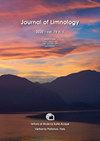Diatom communities and ecological status classification in the upper Po River basin
IF 1.1
4区 环境科学与生态学
Q4 LIMNOLOGY
引用次数: 0
Abstract
One of the main challenges in river management is the setting of nutrient thresholds that support good ecological status, which is the main objective to achieve for the European member states. This is a complex process, which needs an accurate analysis of the data collected so far for the ecological classification of rivers belonging to different typologies. We analysed the data of the multiannual monitoring concerning diatoms and nutrients in the upper Po River (NW Italy) with the aim of exploring the response of diatom community in terms of species composition, ecological guilds and indices. We considered data of 390 samples, of which 2/3 belonging to the “Central macrotype” (i.e. lowland stretches) and 1/3 to “Alpine siliceous”. We performed a Principal Coordinate Analysis to detect community patterns with respect to water chemical classification and macrotypes highlighting species and ecological guilds characteristic of samples along a water quality gradient. We then performed a partial RDA to focus on the role of environmental and spatial factors in shaping the diatom community in each of the two macrotypes. Finally, we investigated the concordance between the Italian normative indices ICMi (for diatoms) and LIMECO (a chemical index of water quality). We found significant differences in the diatom communities of the two macrotypes and in their response to water quality and to spatial factors. Communities resulted as much more uniform in sites with a low water quality, with characteristic species such as Navicula gregaria, Nitzschia palea and Sellaphora nigri. On the other hands, moderately disturbed sites (in terms of trophic level) were characterised by the highest guild diversity. The RDA confirmed the importance of spatial factors in shaping the diatom assemblages, especially in Alpine streams where the physical barriers may condition species dispersion. The comparison between the two normative indices highlights that the correspondence in the classification is achieved in the 57% (Alpine macrotype) and 43% (Central macrotype) of samples. According to our findings, we suggest the revision of the ICMi, both class boundaries and reference value. In addition, we recommend to lower LIMECO threshold for total phosphorus: indeed, several studies have shown significant changes in the diatom community composition starting from very low values (below the current LIMECO threshold, i.e. 50 µgL-1). Moreover, the extension of our study to the whole Po River basin will complete our knowledge of species not yet included in the diatom indices and of the community response to nutrient levels also in other macrotypes.蒲河上游流域硅藻群落及生态状况分类
河流管理的主要挑战之一是设置支持良好生态状况的营养阈值,这是欧洲成员国要实现的主要目标。这是一个复杂的过程,需要对迄今为止收集的数据进行准确分析,以便对属于不同类型的河流进行生态分类。我们分析了波河上游(意大利西北部)硅藻和营养物的多年监测数据,目的是探索硅藻群落在物种组成、生态群落和指数方面的响应。我们考虑了390个样本的数据,其中2/3属于“中央宏观类型”(即低地伸展),1/3属于“阿尔卑斯硅质”。我们进行了主坐标分析,以检测水化学分类和宏观类型方面的群落模式,突出了水质梯度样本的物种和生态群落特征。然后,我们进行了部分RDA,重点研究环境和空间因素在形成两种大型硅藻群落中的作用。最后,我们调查了意大利硅藻标准指数ICMi和水质化学指数LIMECO之间的一致性。我们发现这两种大型硅藻群落及其对水质和空间因素的反应存在显著差异。在水质较低的地区,群落也更加均匀,有特征物种,如黑脊藻、白脊藻和黑珍珠藻。另一方面,中度扰动的地点(就营养水平而言)具有最高的公会多样性。RDA证实了空间因素在形成硅藻群落中的重要性,特别是在阿尔卑斯山脉的溪流中,那里的物理屏障可能会影响物种的分散。两个标准指数之间的比较突出表明,57%(阿尔卑斯宏观型)和43%(中央宏观型)的样本在分类中实现了一致性。根据我们的研究结果,我们建议对ICMi进行修订,包括类别边界和参考值。此外,我们建议降低总磷的LIMECO阈值:事实上,几项研究表明,硅藻群落组成从非常低的值开始发生了显著变化(低于当前的LIMECO阀值,即50µgL-1)。此外,将我们的研究扩展到整个波河流域,将使我们了解尚未纳入硅藻指数的物种,以及其他大型硅藻对营养水平的群落反应。
本文章由计算机程序翻译,如有差异,请以英文原文为准。
求助全文
约1分钟内获得全文
求助全文
来源期刊

Journal of Limnology
地学-湖沼学
CiteScore
2.70
自引率
6.20%
发文量
12
审稿时长
3 months
期刊介绍:
The Journal of Limnology publishes peer-reviewed original papers, review papers and notes about all aspects of limnology. The scope of the Journal of Limnology comprises the ecology, biology, microbiology, physics, and chemistry of freshwaters, including the impact of human activities, management and conservation. Coverage includes molecular-, organism-, community-, and ecosystem-level studies on both applied and theoretical issues. Proceedings of workshops, specialized symposia, conferences, may also be accepted for publication.
 求助内容:
求助内容: 应助结果提醒方式:
应助结果提醒方式:


